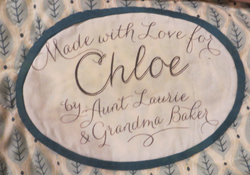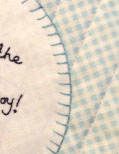Shadywood Quilts
Professional Machine Quilting
Should you put a Quilt Label on Your Quilt?
Hmmm, you are almost getting your quilt finished, I know you are thinking, just get the binding on there and I am DONE! But wait! Have you put a label on this quilt?
Did you know that a quilt label is very important and should be a part of every quilt that is made? No matter how big or small, a quilt label should be on each and every quilt. After all, most quilts will last a lifetime or longer. You are making history when you create a quilt so let’s preserve that history so our grandchildren, great grandchildren, nieces, nephews, great nieces, great nephews, etc. know who made the quilt they love.
Just a Simple Quilt
I know, you might be thinking that what you made is 'just a simple quilt' or 'fill in the blank'. The reality is that many of the quilts YOU have made are going to be around for a long time after you are gone! Really. Quilts (and crocheted throws) that my kids grandmother or grand-grandmother made have already been passed on to my two daughters. Recently, my oldest daughter asked me WHO made this, that and the other quilts (& crocheted throws) that she had stored in a cedar chest.
I can assure you that NONE of my grandmothers or great-grandmothers labeled their quilts. I only know the history of them because my Grandma Scarlett would tell us about each quilt when we came to visit (Think "Bed - Turning*"). I only have what I can remember when I was still in school what my Grandma said about each quilt.
Several Reasons
They were so thrilled with it that they put it away for good (You know, like you put grandmas china away for special use!)
You know quilt was special, but don't want to mess it up. (My folks USED the heirloom type quilts my great-grandmothers made}
What is a Quilt Label?
Quilt labels can be made in many ways. They can be very elaborate and hand made. They can be printed off a home printer. They can be hand embroidered or machine embroidered. And they can even be made just by signing the back of a quilt with a fine point permanent marker. (If you are going to do this, I would highly recommend that you test your permanent marker on a scrap of backing fabric to make sure it is not going to bleed through to the front of your quilt.)
What information should you put on your quilt?
When deciding what to put on a quilt label ask yourself these questions:
1. What is the name of the quilt?
2. Was the quilt made for someone special or an event?
3. Who pieced the quilt?
4. Where was the quilt pieced? (City & State)
5. When was the quilt finished? (Month & Year)
6. Who quilted it & where was it quilted? (This is optional)
Here is a an example of what a quilt label might look like:
 In this case, my sister-in-law (Aunt Laurie) pieced the top, and I (Grandma Baker) quilted it for my grand-daughter Chloe. No dates or locations. But, it still gets the important info on the label. Usually, the labels I make are more of a rectangle, but these demanded that they be an oval shape.
In this case, my sister-in-law (Aunt Laurie) pieced the top, and I (Grandma Baker) quilted it for my grand-daughter Chloe. No dates or locations. But, it still gets the important info on the label. Usually, the labels I make are more of a rectangle, but these demanded that they be an oval shape.
Other Types of Labels

Embroidered: This was a label that I embroidered on a quilt that I completed in 1988. Little crude and information was a bit lacking, but it certainly won't ever wash out!
 The label on the left shows a label that was attached using an embroidery stitch called a 'blanket stitch'. The thread matches the backing fabric. Without seeing the entire label, can't you just imagine that this quilt was given to a young boy!
The label on the left shows a label that was attached using an embroidery stitch called a 'blanket stitch'. The thread matches the backing fabric. Without seeing the entire label, can't you just imagine that this quilt was given to a young boy!
Whatever type of documentation you prefer, just keep in mind that adding this last little touch to your quilt is not about self-recognition. It is letting those of future know the who, what, where, when and why this quilt was made.
*Bed-Turning
Those unfamiliar with the term "bed turning" are in for a treat! Bed turnings are the precursor to our modern "show and tell" programs at quilt guild meetings. Many years ago, women did not have many occasions to get together socially; when they did, it was usually at someone's home. They would each bring a quilt to share, and since space was limited, they would lay them all out on a bed, stacked one on top of the other. Each woman would take a turn, and her quilt would be held up for everyone to see and exclaim over while she told the quilt's story.
In my case, Grandma Scarlett stored many completed quilts in the 'Guest Bedroom'. When we arrrived (after traveling about 700 miles from Wichita KS to the Western Slope of Colorado). We usually arrived late in the evening or early in the morning. No matter, it seemed the first thing that happened was my Grandma Scarlett showing us quilts and telling how and why each were made. Some of my best memories.
Today, Bed Turnings can be seen at quilting events in themed groupings, or chronologically to appreciative audiences who are intrigued with the stories the quilts can tell.
Read Quilt Label Tutorial if you would like to create your own quilt label.
Original Post: June 2003, updated Oct 2022